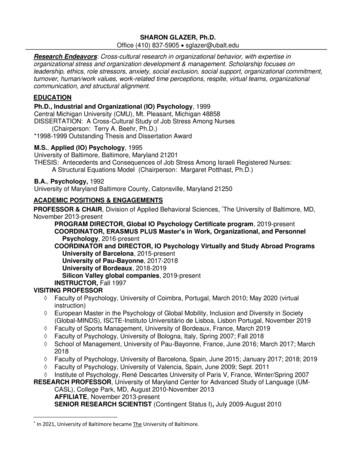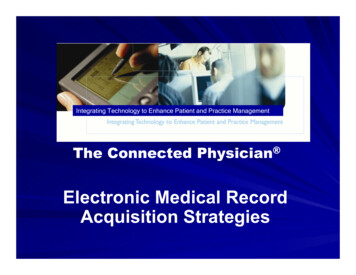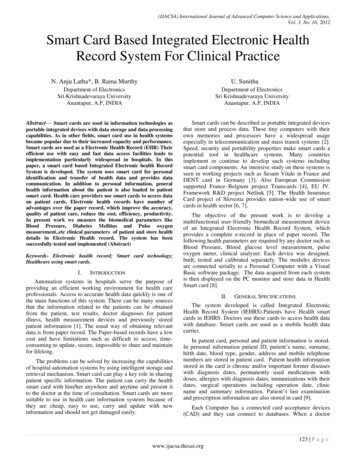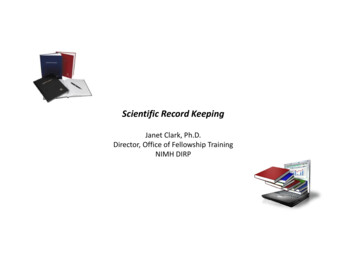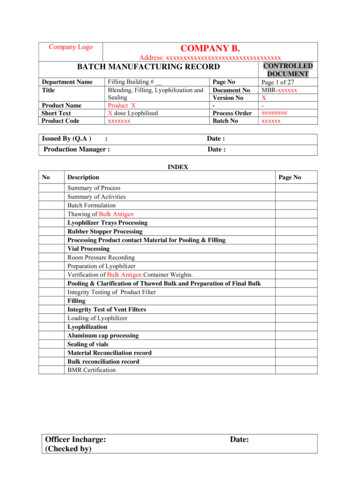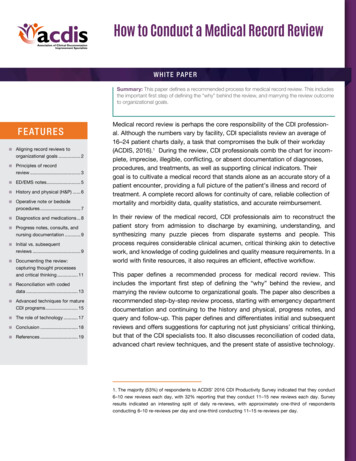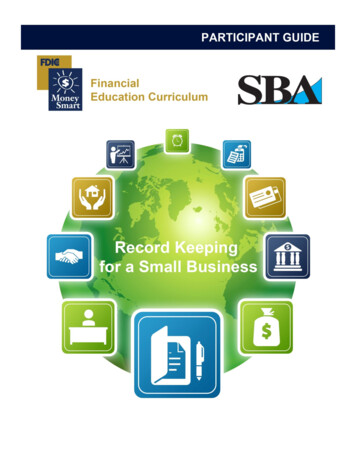
Transcription
TRANSPORTATION RESEARCHRECORDNo. 1498Planning and AdministrationTransportation Finance,Training, StrategicManagement, andEconomic AnalysisA peer-reviewed publication of the Transportation Research BoardTRANSPORTATION RESEARCH BOARDNATIONAL RESEARCH COUNCILNATIONAL ACADEMY PRESSWASHINGTON, D.C. 1995
Transportation Research Record 1498ISSN 0361-1981ISBN 0-309-06162-8Price: 27 .00Subscriber CategoryIA planning and administrationEdward A. Beimborn, Richard K. Brail, Michael S. Bronzini, Katherine L.Davis, Roger L. Dean, Marvin C. Gersten, Edwin W. Hauser, FrederickHugo, Joyce H. Johnson, Elaine E. Joost, C. Jotin Khisty, Patricia L. Lees,John M. McCullough, Charles T. Morison, Jr., Neville A. Parker, CalvinRoberts, John Ross, Kwnares C. Sinha, Louis B. Stephens, Jr., C. MichaelWalton, Eugene M. WilsonCommittee on Transportation and Economic DevelopmentPrinted in the United States of AmericaSponsorship of Transportation Research Record 1498GROUP I-TRANSPORTATION SYSTEMS PLANNING ANDADMINISTRATIONChairman: Thomas F. Humphrey, Massachusetts Institute of TechnologyManagement and Administration SectionChairwoman: Julie Hoover, Parsons Brinckerhoff, Inc.Committee on Taxation and FinanceChairman: Norman H. Wuestefeld, Wilbur Smith AssociatesSecretary: Germaine G. Williams, Federal Highway AdministrationAndrea R. Bozza. Thomas W. Bradshaw, Jr., Robert Clarke Brown, GeroldEstermann, Mark A. Euritt, Enrico Fabi, David J. Forkenbrock, Terry L.Gotts, Martin J. Hemingway, Loyd R. Henion, Arthur C. Jacoby, AnthonyR. Kane, Walter D. Kreutzen, Christopher R. Mann, Amy A. O'Leary, ShivaK. Pant, Elizabeth A. Pinkston, Wayne B. Placide, Clyde E. Pye rs, RobertC. Ricci, Suzanne H. Sale, Frank J. Smith, Marci Herzlinger Tavashi,Porter K. Wheeler, Fred L. Williams, Jenifer Wishart, Janice TurtoraZagardoCommittee on Management and ProductivityChairwoman: Kathleen E. Stein-Hudson, Howard Stein-HudsonAssociates, Inc.Secretary: Barbara Martin, Montana Department of TransportationLuz B. Allende, Daniel L. Dornan, Henry Droughter, Deborah WathenFinn, Judy Guerrero, Barbara Thomas Harder, Robert C. Johns, Parviz A.Koushki, George T. Lathrop, Shyu-Tu Lee, Carol LeFevre, Arthur J.Morse, Daniel B. Pritchard, Elfin Reisner, Frankie G. Rodwell, Suzanne H.Sale, Jane L. Shiatte, Roy Sparrow, William G. Stringfellow, Cindy M.TurvyCommittee on Transportation Education and TrainingChairman: Louis J. Pignataro, New Jersey Institute of TechnologyChairman: David J. Forkenbrock, University of IowaMichael Bell, Fredric S. Berger, Stewart E. Butler, Gary DeCramer,Randall W. Eberts, Norman S. J. Foster, James S. Gillespie, Terry L.Gotts, John F. Hornbeck, Andrew M. Isserman, Hal S. Maggied,Sharon B. Megdal, Deb L. Miller, Susan Jones Moses, Bahar B.Norris. Robert D. Owens, Elizabeth A. Pinkston, Wayne B. Placide,Farideh Ramjerdi, Kenneth D. Simonson, Theresa M. Smith,Robert J. ZuelsdoifCommittee on Strategic ManagementChairman: George T. Lathrop, Charlotte Department of TransportationSecretary: Sidney Davis, Southern College of TechnologyKenneth Asp, Linda Bohlinger, Mark Ford, John Glover, Mark P.Howard, Robert C. Johns, Sheila A. Keller, Lewis LeFevre, JamesP. Redeker, Noreen J. Roberts, Aad Ruhl, Constance S. Sorrell,Kathleen E. Stein-Hudson, William G. Stringfellow, Darwin G. Stuart,Roger TolemanTransportation Forecasting, Data, and Economics SectionChairwoman: Mary Lynn Tischer, Virginia Department of TransportationCommittee on Transportation EconomicsChairman: Ralph C. Erickson, Federal Highway AdministrationGary R. Allen, Kazem Attaran, Fredric S. Berger, Susan J. Binder,Jan L. Botha, Stewart E. Butler, Mark A. Euritt, Asif Faiz, AndrewFarkas, David J. Forkenbrock, Edwin W. Hauser, R. Ian Kingham,Richard S. Marshment, Jeffery L. Memmott, Marcelo J. Mine, Roger D.Mingo, Ibrahim M. Mouaket, Richard R. Mudge, Bahar B. Norris,Farideh Ramjerdi, Christian Reynaud, Steven M. Rock, Aad Ruhl,Guillaume Shearin, Yorgos J. Stephanedes, Janice Turtora Zagardo,Robert J. ZuelsdoifTransportation Research Board StaffRobert E. Spicher, Director, Technical ActivitiesKenneth E. Cook, Transportation EconomistNancy A. Ackerman, Director, Reports and Editorial ServicesSponsorship is indicated by a footnote at the end of each paper. Theorganizational units, officers, and members are as of December 31,1994.
Transportation Research Record 1498ContentsForewordvHighway Use Tax Alternatives for Heavy Trucks in OregonRobert E. Russell1Toll Revenue and Traffic Study of Highway 407 in TorontoAli Mekky5Road Transport in France: Its Balance Account for Public FinanceRichard Darbera16AM/PM Congestion Pricing with a Single Toll PlazaOwen J. Chen and David Bernstein23Socioeconomic Considerations of Road Impact FeesArthur C. Nelson and Thomas W. Sanchez32An Overview of the Russian Road Financing SystemFranck Bousquet, Cesar Queiroz, and Oleg Skvortsov36Facilitating Transportation Agency Management Through PerformanceMeasurement: The NYSDOT Experience with the "Management PerformanceIndicators" ReportRichard Albertin, Jackie Romeo, Lynn Weiskopf, John Prochera, and John Rowen44Succession Planning at the State DOT LevelLester A. Hoel and Michael A. Perfater51Transportation Planning Education in Urban and Regional PlanningGraduate ProgramsKatherine F. Turnbull57
Strategic Planning, Total Quality and Performance Measurement:A Quality Director's ViewJames S. Etmanczyk65Implications of Comprehensive Peace on the Middle East'sTransportation Sector71Mohammad M. Hamed and Bashir Kh. Al-Zu 'biModel Improvements for Evaluating Pricing Strategies75William G. Allen, Jr.Impact of Stream Degradation on Bridges and Rural Travel Patterns82Xing Yang, Marty J. McVey, Landon L. Morris, and C. Phillip BaumelEconomic Feasibility and Related Issues of Highway Shoulder Rumble StripsA. M. Khan and A. BacchusAllocating Pollution Costs Using Noise Equivalency FactorsL. R. Rilett92102
ForewordThe papers in this volume deal with issues related to transportation finance, management, training, andeconomic development and analysis.Three papers review international transportation finance. One paper focuses on toll revenues and atraffic study in Toronto, Canada; another examines cost allocation and equity of road user taxes inFrance; and the other presents an overview of the Russian road financing system. On the domesticfront, one paper focuses on highway use tax alternatives applied to heavy trucks in Oregon, and twopapers consider innovative financing techniques of congestion pricing, using a single toll plaza, andthe socioeconomic consequences of applying highway impact fees.The organizational structure of transportation agencies and managers' roles are undergoingsubstantial change. Four papers look at different aspects of this change and how to respond to it. Eachpaper discusses one of the following topics: (a) management performance indicators; (b) managementsuccession planning; (c) the application of strategic planning, total quality management, andperformance management to transportation organizations; and (d) transportation planning education.Several papers in this volume address a diversity of economic issues. Presented are an appraisal ofthe economic implications on the transportation sector of a comprehensive peace in the Middle East,a model for evaluating pricing strategies, the economic consequences of stream degradation onhighways and bridges, and the economic feasibility of rumble strips constructed along highwayshoulders.·v
TRANSPORTATION RESEARCH RECORD 1498Highway Use Tax Alternatives forHeavy Trucks in OregonROBERTE.RUSSELLThis paper presents a policy analysis of highway use tax alterna ivesfor heavy trucks. It compares registration fees, fuel taxes and we1ghtdistance taxes in terms of equity, compliance costs, administrativecosts, and evasion potential. Three different tax scenarios are evaluatedfor the state of Oregon. The conclusion is that continued reliance on theweight-distance tax is the best option for Oregon.Highway use tax systems are made up of three basic elements:vehicle registration fees, fuel use taxes, and "third structure" taxes.Vehicle registration fees are flat fees that must be paid on an annualor biennial basis and are generally associated with the vehiclelicense plate. Fuel use taxes are collected in cents per gallon of fuelpurchased or used in a state. Third structure is the catchall classification that includes other taxes associated with the use of highwaysor operation of a vehicle.Third structure taxes take a variety of forms, including advalorem (property) taxes, fees, tolls, weight-distance taxes, andother miscellaneous charges extracted from the motoring public.However, the trucking industry normally associates the term withton-mile or weight-distance taxes. This type of tax is collected in theform of a rate per mile of travel based on the weight of the truck.Oregon's highway use tax system is relatively simple. All vehicle owners pay a registration fee. In addition, automobile ownerspay highway use tax in the form of fuel taxes. Heavy-truck operators pay no fuel taxes in Oregon but they do pay the weight-distancetax. This is a unique arrangement. Currently, five other states usethe weight-distance form of taxation, but they also collect fuel usetaxes from the trucking industry. Oregon is the only state that doesnot collect a fuel use tax on heavy-truck fuels.Oregon has a unique history in terms of highway use taxation. In1919 Oregon became the first state in the nation to use fuel taxes tofinance highway and road construction. In 1933 Oregon implemented the nation's first weight-distance tax, of the ton-mile type.Under a ton-mile system, a different tax rate is charged for each loadtransported by truck. In 1937 Oregon completed the first costresponsibility or cost allocation study. Such studies allocate the costof highways proportionally to all highway users. In 1947 Oregonchanged its ton-mile tax to the present weight-distance system, inwhich a single tax rate is charged for all miles of travel based on thehighest operating weight of the truck. This tradition of leadership inthe highway use tax area has continued. In 1990 Oregon implemented the first axle weight-distance tax that explicitly considersaxle weights in the structure of the tax rates.The trucking industry's opposition to Oregon's weight-distancetax began as early as the 1950s. In 1952 the industry sponsored aTransportation Program, Public Utility Commission of Oregon, 550 CapitolStreet, Salem, Oregon 97304.referendum that would have made weight-distance taxes unconstitutional. This measure failed by a 4-to- l margin. However, opposition to the weight-distance tax continues today. The truckers' objections are that weight-distance taxes do not approximate highwaycosts, administrative and compliance costs are high, and evasion iswidespread (J). A discussion of these issues follows.EQUITYThe contention that weight-distance taxes do not approximate highway costs is in reality a claim that . this form of taxation isinequitable. In commercial trucking, tax equity is a significant issue.Trucking companies compete based on the efficiency with whichthey run their companies and the services they provide. An equitable tax, therefore, would be transparent in the marketplace. Toachieve this objective, all users must pay their fair share for the useof the highway system. This is the underlying principle of costresponsibility that Oregon has long used to allocate highway costsamong users of the system.Two aspects of equity, horizontal and vertical, are considered inOregon's cost responsibility studies. Horizontal equity means equaltreatment of equals: owners of vehicles that have equal highwaywear characteristics should pay the same amount of highway usetaxes. Vertical equity means that unequals are tre·ated unequally.For example, an owner of a truck that weighs 36 320 kg (80,000 lb)should pay more taxes than an owner of a truck that weighs 11 804kg (26,000 lb). To achieve true equity, the tax system must achieveboth horizontal and vertical equity.The Oregon cost responsibility approach makes a basic distinction between the cost impacts of cars and trucks. Highway costs areallocated between the two groups based on traffic characteristics,level of highway expenditures, and engineering requirements.Using these three components, Oregon's 1992 Cost ResponsibilityStudy determined that cars are responsible for 61.3 percent of thestate's road costs and trucks are responsible for 38.7 percent (2).Once this basic allocation is made, trucks are further dividedinto 908-kg (2,000-lb) increments or classes to determine theappropriate cost responsibility for each group. The Oregon studyrecognizes 51 classes of trucks. This approach considers both horizontal and vertical equity.Once cost responsibility characteristics are determined for eachvehicle class, the tax system, to achieve true horizontal equity, mustreflect the variability of actual usage. For example, a 21 792 kg(48,000 lb) truck being driven 161 km (100 mi) represents less costthan an identical vehicle being driven l 610 km (1,000 mi) andshould, therefore, pay proportionately less tax. Registration fees areflat taxes and do not reflect actual highway usage. However,Oregon's registration fees do vary according to the weight of the
2vehicle. There is an element of vertical equity. Because usage is notreflected, however, horizontal equity is not fully addressed.Unlike registration fees, fuel taxes reflect usage. The more milestraveled, the more fuel burned and the more tax paid. Fuel taxeshave an element of horizontal equity, but they do not reflect vertical equity because fuel consumption does not increase proportionately with increases in the weight of the vehicle. For example, a1986 study found that the cost responsibility of an 36 320-kg(80,000-lb) truck is double that of a 22 700-kg (50,000-lb) truck,but the 36 320-kg (80,000-lb) truck uses only about 14 percentmore fu
However, the trucking industry normally associates the term with ton-mile or weight-distance taxes. This type of tax is collected in the form of a rate per mile of travel based on the weight of the truck. Oregon's highway use tax system is relatively simple. All vehi cle owners pay a registration fee. In addition, automobile owners


